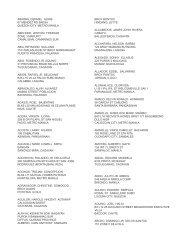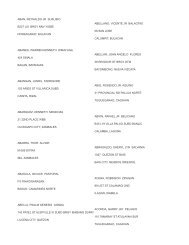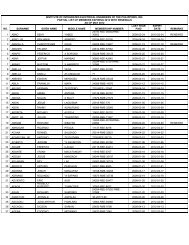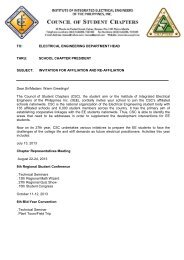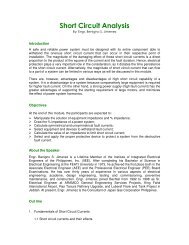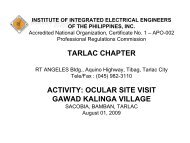2012-Transformer-loss_eva... - Institute of Integrated Electrical ...
2012-Transformer-loss_eva... - Institute of Integrated Electrical ...
2012-Transformer-loss_eva... - Institute of Integrated Electrical ...
You also want an ePaper? Increase the reach of your titles
YUMPU automatically turns print PDFs into web optimized ePapers that Google loves.
INSTITUTE OF INTEGRATED ELECTRICAL ENGINEERS 2<br />
SIC is the cost installing transmission line with a kW <strong>of</strong><br />
capacity<br />
Loss Cost Rate refers to NLLCR or LLCR or<br />
ALCR1/ALCR2<br />
FCRG is the Fixed Charge Rate <strong>of</strong> Generating Plant<br />
FCRT is the Fixed Charge Rate <strong>of</strong> <strong>Transformer</strong><br />
FCRS is the Fixed Charge Rate <strong>of</strong> Transmission<br />
h is the number <strong>of</strong> hours per year that transformer is<br />
energized<br />
The Fixed Charge Rate <strong>of</strong> Plant/<strong>Transformer</strong> refers to that<br />
portion <strong>of</strong> investment needed per year to support the capital<br />
investment. In its simplest form, it represents the required<br />
yearly income from the investment. Its components are as<br />
follows;<br />
1) Minimum Acceptable Rate <strong>of</strong> Return<br />
2) Annual Cost <strong>of</strong> Depreciation and<br />
3) Taxes<br />
For purposes <strong>of</strong> this study, FCRT and FCRS are equated<br />
to NGCP’s Weighted Average Cost <strong>of</strong> Capital (WACC) for<br />
the second regulatory period which is 15.87%. FCRG is set<br />
equivalent to 15%, NEDA’s Social Discount Rate.<br />
The numerator in the equation for the Loss Cost Rate<br />
represents the cost per year to provide a continuous kW<br />
<strong>of</strong> <strong>loss</strong>. The first term (GIC × F CRG + SIC × F CRS)<br />
represents that portion <strong>of</strong> investment cost on a generation and<br />
transmission needed per year to support transformer <strong>loss</strong>es<br />
while the second term represents the cost <strong>of</strong> the energy under<br />
the present pr<strong>eva</strong>iling energy cost. For Luzon, the current year<br />
energy cost, CYEC, is set to $0.1444/kWh This is based on<br />
P7.04/kWh 2 energy rate and P48.65/$1 3 peso-dollar exchange<br />
rate.<br />
III. NO LOAD LOSS COST RATE<br />
Following the principles in Section II, the No Load Loss<br />
Cost Rate is determined as follows;<br />
NLLCR =<br />
(GIC×F CRG + SIC×F CRS) + LECN<br />
ET ×F CRT ×IF<br />
Except for ET and IF terms in the denominator, the formula<br />
for NLLCR is similar to the equation for transformer<br />
<strong>loss</strong> in Section II. Note that LECN, the Levelized No Load<br />
Energy cost, is the energy portion in Section II equivalent<br />
to US$ 1,573.43/kWyear for Luzon. LECN is determined in<br />
Section VI. ET and IF are dimensionless factors introduced<br />
to reflect the Efficiency <strong>of</strong> Transmission and Increase Factor<br />
respectively. ET is determined through power flow simulations<br />
and is set to 0.9783 for Luzon Grid. To simplify calculations,<br />
IF is set to 1.007 4 and only reflects project overhead cost.<br />
By introducing ET, the calculated energy, in terms <strong>of</strong> cost<br />
is marked-up to include other costs dissipated through inefficiency.<br />
IF further increments this cost in proportion to project’s<br />
overhead cost.<br />
2 Figures from PSALM<br />
3 Exchange rate forecast from Economist Intelligence Unit as used by NGCP<br />
in the 3rd Reg. Filing<br />
4 Based on actual budget<br />
Values for other variables are as follows;<br />
Generation Installation Cost GIC = $1,600/kW<br />
Generation Installation Cost SIC = $2.74/kW 5<br />
Solving for NLLCR for Luzon Grid;<br />
NLLCR =<br />
(1, 600×0.15 + 2.74×0.1444) + 1, 573.43<br />
(0.9783×0.1587×1.007)<br />
NLLCR = $11, 601.60/kW<br />
IV. LOAD LOSS COST RATE<br />
For the Load Loss Cost Rate, there is a need to remove<br />
the impact <strong>of</strong> the Availability Factor AF 6 from LECN, as<br />
calculated in Section VI since for this <strong>loss</strong> rate <strong>Transformer</strong><br />
Loading Factor TLF will be used. Modifying LECN in this<br />
manner results to LECL or the Levelized Load Energy Cost,<br />
LECL is determined as follows:<br />
LECL = LECN<br />
AF<br />
=<br />
1, 573.43<br />
0.9897<br />
1, 589.8<br />
=<br />
kW<br />
year<br />
With the denominator remaining the same as that for No-<br />
Load Loss Cost Rate, the equation for the Load Loss Cost<br />
Rate is:<br />
LLCR = (GIC×F CRG + SIC×F CRS)×P RF 2 ×P UL 2<br />
(ET ×F CRT ×IF )<br />
2<br />
LECL×T LF<br />
+<br />
(ET ×F CRT ×IF )<br />
The new terms in the numerator are dimensionless adjustment<br />
factors introduced to enable realistic assessment. The<br />
Peak-Per Unit Load (PUL) relates demand-associated <strong>loss</strong>es to<br />
full rated transformer and not to the peak transformer load 7 . It<br />
is the average <strong>of</strong> yearly peaks over the lifetime <strong>of</strong> transformer<br />
divided by the rating at which the load <strong>loss</strong>es are guaranteed<br />
to be tested. For this study, load <strong>loss</strong>es are assumed to be<br />
tested at full-load transformer rating. Using load forecast data<br />
for 2009, PUL is set to 1.114 for Luzon.<br />
The Peak Responsibility Factor (PRF) is the transformer’s<br />
load during system peak 8 , divided the transformer’s peak load.<br />
This factor is intended to compensate for the transformer<br />
peak load <strong>loss</strong>es not occurring at the system peak <strong>loss</strong>es.<br />
The rationale is, if the entire transformer peak does not<br />
occur during the system peak, then there is no need to put<br />
up additional generation since the transformer load and its<br />
<strong>loss</strong>es could be supplied by the system. That is reason behind<br />
inclusion <strong>of</strong> PRF in the demand portion <strong>of</strong> the <strong>loss</strong> assessment<br />
equation. The data used in the determination <strong>of</strong> this parameter<br />
5 Based on $27,365.00/km, 2008 Price Level <strong>of</strong> 5km, 69kV ST/SC, 1-336.4<br />
MCM ACSR<br />
6 Availability Factor AF is the expected percentage <strong>of</strong> time the transformer<br />
will be energize. AF = 0.9897<br />
7 Guide for the Evaluation <strong>of</strong> Large Power <strong>Transformer</strong> Losses, USDA<br />
8 System Peak assumed to occur at 1900H



